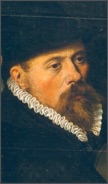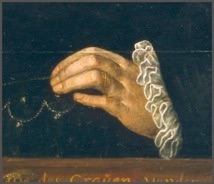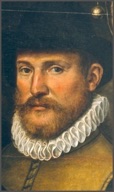The Digitalisation Project Castle Huis Bergh is the intellectual property of the Stichting Musick’s Monument. Ing Hans Meijer was responsible for the technical realisation; Dr Willem Kuiper for the scholarly input. Thanks are also due to the Anjer Cultuurfonds Gelderland; the Stichting de Verenigde Stichtingen “De Armenkorf” in Terborg and “Het Gasthuis te Silvolde”; Mrs P. Tijdink-Hermsen; Mrs L.J.C. Meijer-Kroonder; and the Giese family.




Panel German(?) master Germany(?)
Mint-master Clemens of Eembrugge and his companions 1581.
What we see before us is the only Dutch portrait of a mint-master and his companions. It is the mint-master of Castle Bergh, called Clemens of Eembrugge who is portrayed prominently to the fore. As well as the gentleman himself, the coins also stand in the foreground: Clemens holds one of them up for the benefit of the beholder, while the rest lie in piles on the table. We can count seven companions in total, all dressed in serious black, with white millstone collars, apart from two of them. The men on the far right of the picture are wearing more colourful clothes; one is even clearly decked out as a jester, although his face does not exactly radiate jollity. This jester’s outfit was traditionally worn by the youngest member of a minters’ company. Why this was is not exactly clear. However, the wet-behindthe- ears rookie had to be distinguishable in the world’s eyes from the more experienced members of the group. Perhaps it also had a second function: when the company walked through the town with their precious metals, the bright colours and the tinkling of the bells on the outfit the attracted the attention of passers-by, which would make potential thieves think twice about trying their luck.




Paneel
Duits(?) meester
Duitsland(?)
Muntmeester Clemens van Eembrugge en zijn gezellen 1581
Voor ons hebben wij het enige Nederlandse portret van een muntmeester en zijn gezellen. Het is de muntmeester van Huis Bergh, die Clemens van Eembrugge heette en vooraan prominent staat afgebeeld. Behalve deze heer staan de munten op de voorgrond: eentje houdt Clemens op voor de toeschouwer en de rest ligt in stapeltjes op tafel. In totaal tellen we zeven gezellen, alle in serieus zwart met witte molensteenkragen, behalve twee van hen. De heren helemaal rechts dragen kleuriger kleren; eentje is zelfs duidelijk uitgedost als nar, hoewel zijn gezicht weinig vrolijkheid uitstraalt. Dit narrenpak werd traditioneel gedragen door de jongste gezel van een muntersgezelschap. Wat er precies mee beoogd werd, is niet geheel duidelijk. In elk geval moest het voor de buitenwereld de domme nieuweling onderscheiden van de meer ervaren leden van de groep. Wellicht had het nog een tweede functie: wanneer de gezellen met hun edele metalen door de stad liepen, trokken de felle kleuren en het gerinkel van de bellen aan het pak de aandacht van omstanders, wat diefstal onaantrekkelijk maakte.
